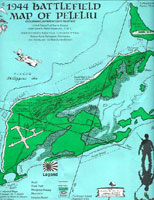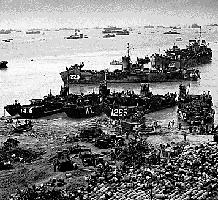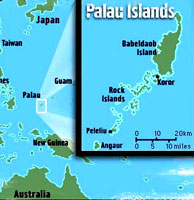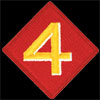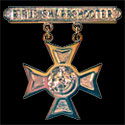| North
High School Wall of Honor Russell C. Churchman, Jr. Class of June, 1942 |
 |
|||||||||||||||||||||||||||||||||||||||||||||||||||||||||||||
| Research done by Claradell Shedd, class of 1953. | ||||||||||||||||||||||||||||||||||||||||||||||||||||||||||||||
| Russell C. Churchman, Jr. | ||||||||||||||||||||||||||||||||||||||||||||||||||||||||||||||
| Russell
graduated in the North High class of June, 1942. Enlisted where? Drafted
where? At the time of his enlistment, his next of kin was R.C. Churchman,
1151 Fourth Street, Des Moines, IA. His service number is 610629. Russell's duty was in the US Marines, GET CORRECT INFO FOLLOWING serving on Paleliu, Palau Islands, and Okinawa, Ryukyu Islands. He was a First Class Rifle SharpShooter and Field Artilleryman. |
||||||||||||||||||||||||||||||||||||||||||||||||||||||||||||||
|
||||||||||||||||||||||||||||||||||||||||||||||||||||||||||||||
| 4th Marine
Division This division was formed by the organization and redesignation of several other units. The 23rd Marine Regiment began as infantry detached from the 3rd Marine Division in February 1943, the same month that an artillery battalion of the 12th Marines became the genesis of the 14th Marines and engineer elements of the 19th Marines formed the nucleus of the 20th Marines. In March the 24th Marine Regiment was organized, and then in May it was split in two to supply the men for the 25th Marines. This war-time shuffling provided the major building blocks for a new division. The units were originally separated, however, with the 24th Marines and a variety of reinforcing units (engineer, artillery, medical, motor transport, special weapons, tanks, etc.) at Camp Pendleton in California. The rest of the units were at Camp Lejeune, North Carolina. This East Coast echelon moved to Pendleton by train and transit of the Panama Canal in July and August. When all the units were finally together, the 4th Marine Division was formally activated on August 14, 1943, with Major General Harry Schmidt in command. After intensive training, it shipped out on 13 January 1944, and in 13 months made four major amphibious assaults, in the battles of Kwajalein (Roi-Namur), Saipan, Tinian, and Iwo Jima,[3] suffering more than 17,000 casualties. It was awarded two Presidential Unit Citations and a Navy Unit Commendation, and then deactivated 28 November 1945. The division patch worn on Saipan had a gold "4" on a scarlet background, the official colors of the U.S. Marine Corps. The emblem was designed by SSgt John Fabion, a member of the Division's Public Affairs Office before the Marshalls Campaign. His commanding officer was astonished to find that when the Division attacked Roi Islet in Kwajelein Atoll in the Marshall Islands (January 1944), the layout of the runways on the airstrip there were an exact replica of the "4". The 4th had two Seabee Battalions posted to it during the war. The 121st Naval Construction Battalion was posted to the 20th Marines and redesignated as the 3rd Battalion of the Regiment. They landed with the 4th on Roi-Namur, Saipan and Tinian and received a Presidential Unit Citation for it. The 20th was deactivated and the 121st stayed on Tinian to work on the airfields when the 4th moved on.. They were replaced by the 133rd NCB for assault on Iwo Jima. The 133rd was posted to the 23rd Marines as their shore party until relieved on D plus 18. US Naval Powder Factory, Indian Head, MD The World War II years brought rapid growth to the Indian Head Naval Powder Factory, which was considered one of the leading war-supply stations. After war had broken out in Europe but before the United States entered the war, 62 uniformed personnel and 794 civilians were employed at the Naval Powder Factory. To accommodate workers during the war, the Navy constructed additional housing in the area now known as the Village Green and also constructed the Potomac Heights and Woodland Village neighborhoods. Construction of the Indian Head Highway was initiated during the war, and the Navy provided bus service between Washington and Indian Head. During World War II, the Navy facility produced flashless powder and pellets, and research was conducted in rocketry and development of air-to-ground anti-tank weapons. In cooperation with researchers at the California Institute of Technology in Pasadena, Calif., Indian Head put into operation an extrusion plant for pressing ballistite powder into rocket "grains," while continuing to produce smokeless powder and Explosive D. The expansion into production of extruded grains would reshape the destiny and mission of the facility. By 1945, Indian Head numbered 5,217 civilians and military personnel, now not only making smokeless powder, but testing rocket fuel and experimenting with mines and other ordnance. During the period 1946 through 1949, the station's commanding officers worked with civilian researchers and with the Bureau of Ordnance in attempting to get the official mission of the Indian Head Powder Factory modified to reflect its new strengths. Although the Powder Factory had taken on a research and development emphasis, the larger scale employment at Indian Head depended upon the production facilities. With the decline in smokeless powder consumption and with the layoff of employees in the postwar months, congressmen and senators from Maryland soon came to the defense of the facility. Shortly after these political pressures, the Bureau agreed to the establishment of a set of pilot plants at Indian Head which would have the capacity to produce experimental new propellants for naval research use. By the summer of 1947, the Bureau of Ordnance agreed to a plan to construct four pilot plants at Indian Head to include a nitroglycerin pilot plant; a plant to produce varied nitrogen-content nitrocellulose; a plant for mixing and rolling experimental lots of solvent and solventless propellant; and a fourth plant for experimental production of cast propulsion units. Over the next six years, Indian Head gradually built up its "pilot plant" capacity, building on strength in experimental propellants. Coming at a time of crisis, the pilot plants began to reshape the mission of Indian Head as its redefinition slowly emerged. |
||||||||||||||||||||||||||||||||||||||||||||||||||||||||||||||
|
||||||||||||||||||||||||||||||||||||||||||||||||||||||||||||||
|
||||||||||||||||||||||||||||||||||||||||||||||||||||||||||||||
|
||||||||||||||||||||||||||||||||||||||||||||||||||||||||||||||
|
||||||||||||||||||||||||||||||||||||||||||||||||||||||||||||||
| Deceased: 02/09/87. | ||||||||||||||||||||||||||||||||||||||||||||||||||||||||||||||
| Music: "Semper Fidelis" | ||||||||||||||||||||||||||||||||||||||||||||||||||||||||||||||
| Home
|
Back/allyears |
WWI |
WWII |
Korea |
Vietnam |
Afghanistan/Iraq |
Lyrics
|
Refs/Awards |
Contact ©2025-csheddgraphics All rights reserved. All images and content are © copyright of their respective copyright owners. |
||||||||||||||||||||||||||||||||||||||||||||||||||||||||||||||
